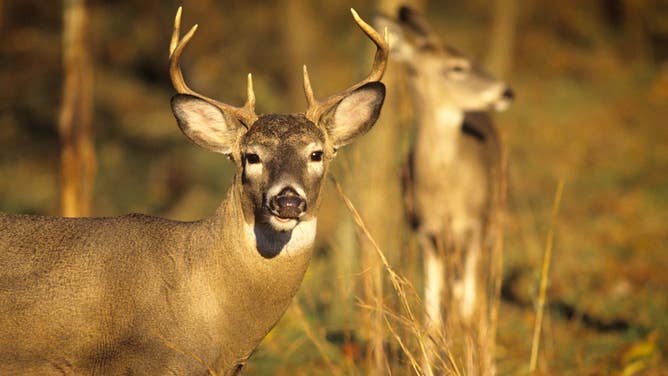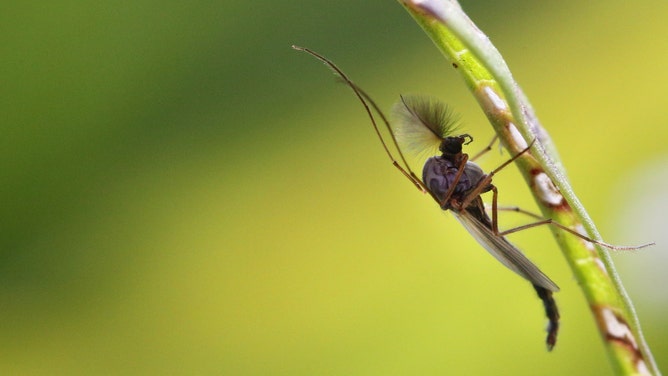People are panicking over ‘zombie deer’ — here are the facts
The sick deer are infected with a painful and sometimes fatal disease called epizootic hemorrhagic disease, or EHD. Deer infected with EHD have been referred to with the misnomer "zombie deer."

A whitetail deer looks for food in the woods.
(Ben Hasty / MediaNews Group / Reading Eagle / Getty Images)
Deer are becoming infected with a disease that’s creeping into Ohio and other parts of the Midwest.
On Monday, police in southern Ohio were called to look into a bizarre sighting on the side of the road.
"This deer was just standing there and unresponsive to us, just like... like it wasn't afraid," said James Love, public information officer for Ohio's Colerain Township Police Department.
According to Love, when the police approached the deer, they saw discolorations on its coat and that, despite their close proximity, the deer didn’t move.
"It was a total surprise to all of us," said Love. "We’ve never seen anything like that."
What is making the deer sick?

A deer fawn curled up in the grass by the Potomac River.
(Gerald Elkin / National Park Service)
What the police saw was a deer suffering from a disease called epizootic hemorrhagic disease, or EHD.
EHD has traditionally occurred in deer in the Southeast United States, where the deer have developed an immunity to the disease. But for deer in Ohio and other parts of the Midwest, where EHD is becoming more prevalent, EHD can be deadly.
When a deer is suffering from EHD, it may experience drooling and swelling. However, other symptoms of the disease run deeper in deer.
"They're experiencing a lot of things that are not visible to the naked eye," said Michael Tonkovich, the deer program administrator for the Division of Wildlife at the Ohio Department of Natural Resources.

A buck stands in the foreground, while a doe stands in the background.
(J. Irwin / Classicstock / Getty Images)
According to Tonkovich, infected deer develop a high fever, along with ulcers inside their body and internal bleeding. Because of these injuries, walking can become painful for the deer, so they may try to move by crawling on their knees.
The sick deer also experience behavioral changes, such as depression. The deer may appear listless and lethargic and may be found walking in circles.
Deer infected with EHD have been referred to with the misnomer "zombie deer." Tonkovich cautions against using the term to describe any deer disease or unusual deer behavior.
"The unfortunate label originated with another serious, always fatal deer disease – Chronic Wasting Disease," he said. "As a result, many now are confused about what is killing these deer in Ohio and Indiana. To be clear, it is hemorrhagic disease, not CWD and surely not some Z-disease."
How the disease is transmitted

A midge, resting on a plant. Midges are carriers of the disease EHD.
(Creative Touch Imaging Ltd. / NurPhoto / Getty Images)
Deer suffering from EHD are infected by biting flies known as midges, or more commonly called "no-see-ums" (from "no see them," as the insects are tiny and difficult to see).
Midges carry the virus that causes EHD. So when insects bite a host, such as a deer, they transmit the virus into the host’s bloodstream.
According to Tonkovich, deer that have been bitten by midges and then infected with the virus may begin exhibiting symptoms of EHD within around 5-7 days. About 8-36 hours after the symptoms develop, the deer may die.
EHD infections tend to become more prevalent during this time of year, particularly when the weather has been dry. This causes pools of standing water and farm ponds to begin to dry up and expose mudflats — these muddy edges are where midges breed.

A farm pond in Ohio.
(Ohio Department of Natural Resources)
"So more and more habitat, more midges, more virus, more dead deer," Tonkovich said. He added that the warm weather also allows midges to breed, lay eggs and hatch more quickly.
The life cycle of midges will only begin to slow down in early November, potentially impacting hunting season in local townships in Ohio.
"Not until the first frost actually kills these midges can we rest on our laurels and catch our breath, assuming that we won't see any further mortality," Tonkovich said.
He noted that the disease is not contagious for humans, dogs or cats.